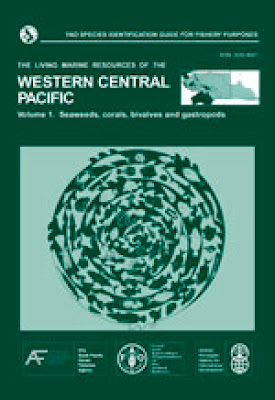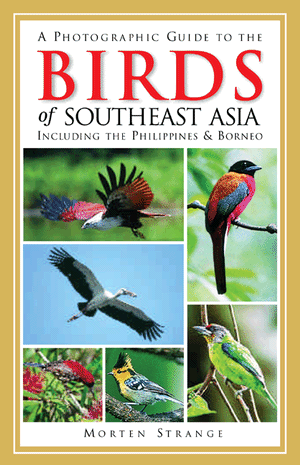In: K. E. Carpenter. V. H. Niem (eds.). FAO species identification guide for fisheries purposes. The living marine Resources of the Western Central Pacific Volume 1. Seaweeds, corals, bivalves and gastropods. Pp. 123-686. Food and Agriculture Organization of the United Nations, Rome, ISBN 92-5-104051-6.
BIVALVES; GASTROPODS.
Some 187 species of bivalves from 35 families (pp. 123-362), and 263 gastropod species from 43 families (pp. 363-686) are described and superbly illustrated in this ambitious volume, which is a welcome addition to the acclaimed series of species identification guides published by the FAO. The geographic area covered in this work stretches from the Malacca Straits eastwards to Piteairn Island in the Pacific Ocean, including the Indonesian archipelago, the Philippines, Papua New Guinea, Northern Territories and Queensland in Australia, and the majority of tropical Pacific islands. The guide is well organized, with sections on general remarks, glossary of technical terms, and shell keys to bivalve and gastropod families which are arranged in a rough phylogenetic sequence. Each family is introduced by way of diagnostic characters, habitat, biology, and fisheries, with comments on similar families occurring in the area, as well as taxonomic references. A strictly conchologial key to species is also provided for each family. Every species treated is illustrated with line and ink. Species descriptions include the following heading: frequent synonyms and misidentifications, FAO names is English and French, diagnostic shell characters, size, habitat, biology, fisheries, and geographical distribution.
BIVALVES; GASTROPODS.
Some 187 species of bivalves from 35 families (pp. 123-362), and 263 gastropod species from 43 families (pp. 363-686) are described and superbly illustrated in this ambitious volume, which is a welcome addition to the acclaimed series of species identification guides published by the FAO. The geographic area covered in this work stretches from the Malacca Straits eastwards to Piteairn Island in the Pacific Ocean, including the Indonesian archipelago, the Philippines, Papua New Guinea, Northern Territories and Queensland in Australia, and the majority of tropical Pacific islands. The guide is well organized, with sections on general remarks, glossary of technical terms, and shell keys to bivalve and gastropod families which are arranged in a rough phylogenetic sequence. Each family is introduced by way of diagnostic characters, habitat, biology, and fisheries, with comments on similar families occurring in the area, as well as taxonomic references. A strictly conchologial key to species is also provided for each family. Every species treated is illustrated with line and ink. Species descriptions include the following heading: frequent synonyms and misidentifications, FAO names is English and French, diagnostic shell characters, size, habitat, biology, fisheries, and geographical distribution.

Adapted from FAO Corporate Document Repository. Accessed on 29th Jun 2007.
According to the editors (p.iv), the purpose of this guide "is to provide an accurate means to identify to the appropriate taxonomic level those organisms that are of potential use or likely to be captured by marine fisheries in the region", and in addition, it is stated (p.iv) that "this work is the first attempt to provide comprehensive identification and biological information for marine resources in the region". The coverage on the whole is fairly comprehensive, with the following twelve families having the highest number (in descending order each for bivalves and gastropods) of species described in the guide: bivalves-Veneridae (33 spp.). Arcidae (16 spp.) Cardiidae (12 spp.). Pectinidae (11 spp.). Mytilidae (10 spp.) and Tellinidae (9 spp.); gastropods-Cypraeidae (25 spp.). Strombidae (23 spp.) Muricidae (21 spp.). Conidae (13 spp.). Naticidae (12 spp.) and Neritidae (11 spp.). Although diagnostic shell characters are not provided for about half of the species included in the guide (markings meant to distinguish species provided with diagnostic characters from those without were unfortunately misprinted), the excellent drawings and keys are adequate for initial identification, at least to the family level. Two omissions, however, are significant in the light of the objectives spelled out by the editors. One is the complete exclusion of the indigenous common names. In my opinion, the exclusion of local name(s) seriously undermines the usefulness of this guide, since the users are likely to be more familiar with the common local name than with French or English names. Of course, if there is no local name referable to the shell, then the FAO name would be a useful suggestion. But to ignore an existing name is not good practice. the second concerns the lack of cited references concerning fisheries biology and aquaculture techniques for the various species presented in the guide. Nearly all references given in the guide are taxonomic in nature, and although the primary role of this guide is identification, it would have been helpful to provide some primary sources of information concerning fisheries and/or aquaculture.
Other details that might be considered for a second imprint of this guide is the addition of the neritid gastropod Nerita lineata (otherwise known as N. birmanica, N. articulata or N. balteata), this species being one of the commonest snails in Malayan mangroves, and consumed by the local coastal population. Nowhere in this guide is it mentioned. Neither is the bivalve Orbicularia orbiculata (Pharidae, formerly in Psammobiidae) for which is a significant fishery exists in Malaysia. The patellogastropod genus Cellana is now placed in the family Nacellidar, following current taxonomic opinion.
Poutier's contribution is a welcome addition to the increasing number of illustrated guides to the molluscan fauna of the Indo-Pacific. While reliable identification aids are available for molluscan fauna in Japan, the Philippines, Java, Australia and New Caledonia, the fauna characteristics of the Malayan archipelago has not been the subject of taxonomic guide books. Although this guide describes only a small fraction of bivalves and gastropods found in the Indo-Pacific, it includes a fair number of species that are treated in detail for the first time. This FAO guide will take its place amongst the useful "must-haves" in the libraries of professional biologists as well as shell enthusiasts.
K.S. Tan
Tropical Marine Science Institute
National University of Singapore
First published in The Raffles Bulletin of Zoology Vol 48(2): 340 on 31 Dec 2000.
Other details that might be considered for a second imprint of this guide is the addition of the neritid gastropod Nerita lineata (otherwise known as N. birmanica, N. articulata or N. balteata), this species being one of the commonest snails in Malayan mangroves, and consumed by the local coastal population. Nowhere in this guide is it mentioned. Neither is the bivalve Orbicularia orbiculata (Pharidae, formerly in Psammobiidae) for which is a significant fishery exists in Malaysia. The patellogastropod genus Cellana is now placed in the family Nacellidar, following current taxonomic opinion.
Poutier's contribution is a welcome addition to the increasing number of illustrated guides to the molluscan fauna of the Indo-Pacific. While reliable identification aids are available for molluscan fauna in Japan, the Philippines, Java, Australia and New Caledonia, the fauna characteristics of the Malayan archipelago has not been the subject of taxonomic guide books. Although this guide describes only a small fraction of bivalves and gastropods found in the Indo-Pacific, it includes a fair number of species that are treated in detail for the first time. This FAO guide will take its place amongst the useful "must-haves" in the libraries of professional biologists as well as shell enthusiasts.
K.S. Tan
Tropical Marine Science Institute
National University of Singapore
First published in The Raffles Bulletin of Zoology Vol 48(2): 340 on 31 Dec 2000.



